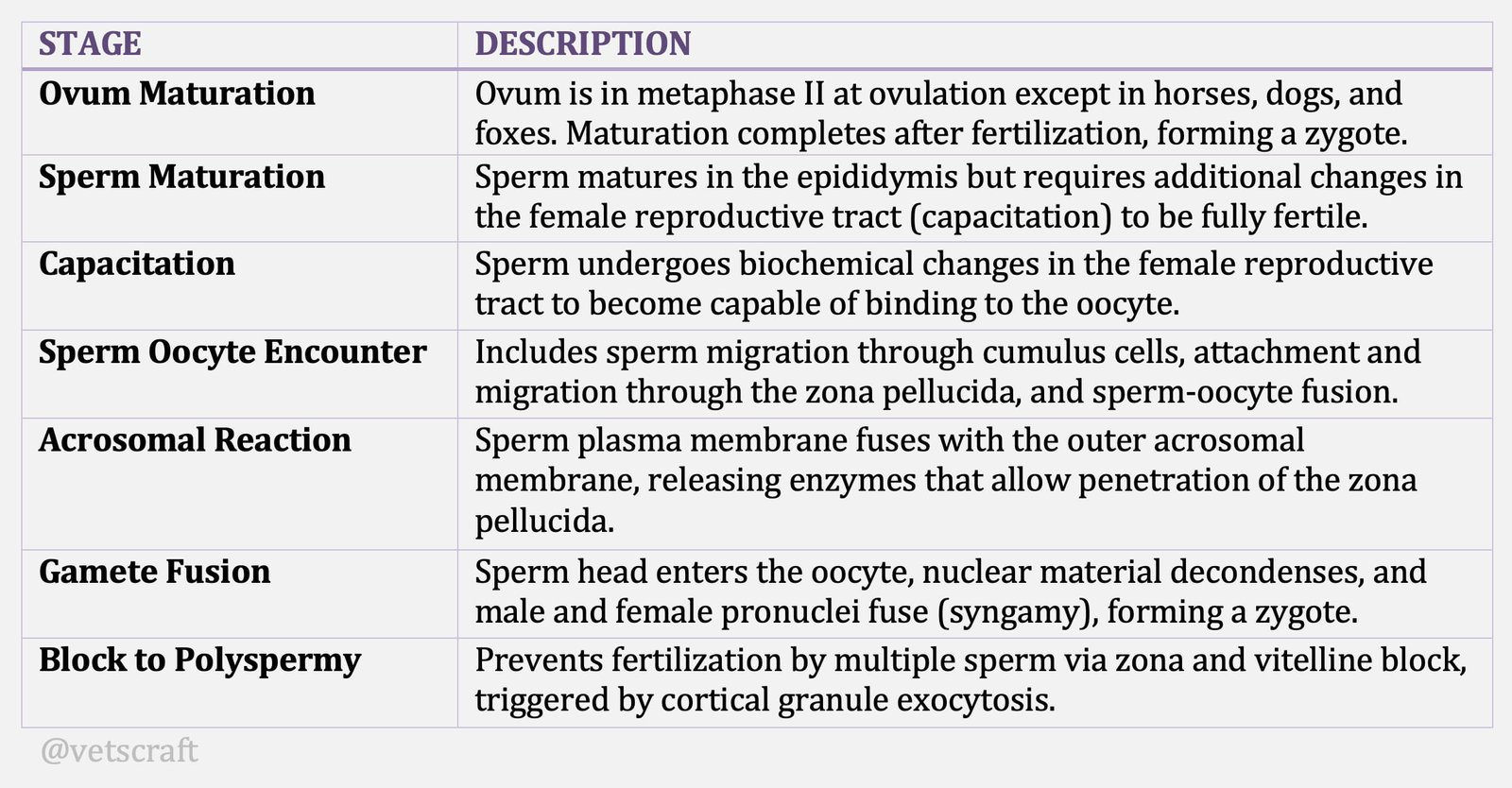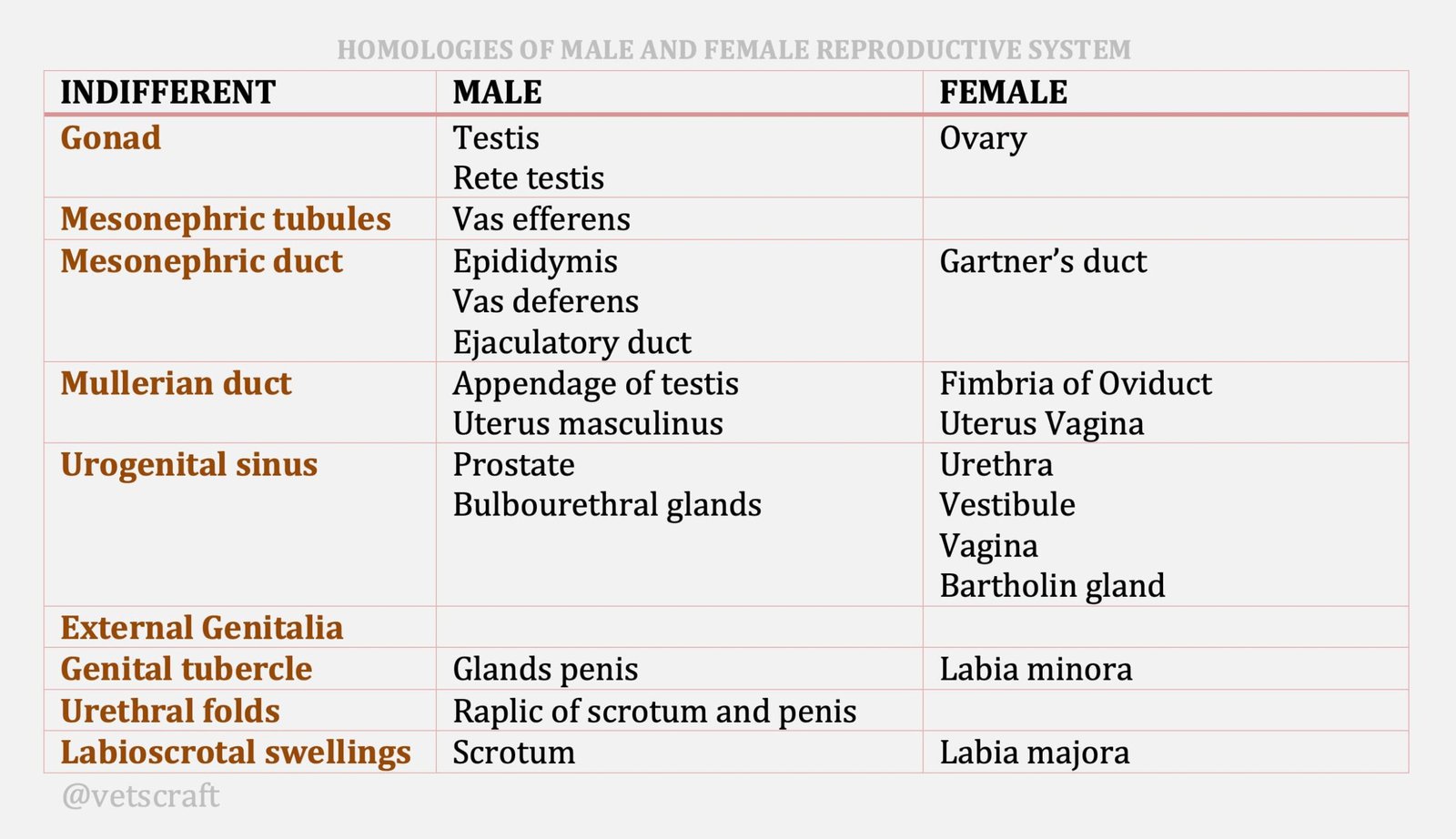Process of Fertilization
The process of fertilization involves ovum maturation, sperm maturation, and interaction of sperm and ovum.

Ovum Maturation
In most species the ovum is in metaphase II of the second meiotic division when ovulated, however, the ova of horses, dog and fox are only in their first meiotic division at the time of ovulation.
Ovum maturation and meiosis are not completed until after fertilization when the ovum becomes a zygote.
Sperma Maturation
Sperm maturation is one of the three events that spermatozoa must undergo before fertilization can be accomplished. It begins during its 10-15 days passage through the epididymis after which fertilization is possible.
However, the maturational changes that occur in the epididymis do not render spermatozoa completely fertile.
For maximum fertility to be achieved, spermatozoa must reside in the female reproductive tract for a minimum period of time during which spermatozoa will undergo changes that allow them to become fertile. These changes are called capicitation.
Capacitation
The site for capacitation varies among species. In species in which spermatozoa are deposited in the anterior vagina, capacitation may begin as sperm ascent and pass through cervix. In species in which semen is deposited in the uterus, capacitation is probably initiated in the uterus and completed in the isthmus of oviduct.
The plasma membrane of epididymal spermatozoa contains a complement of surface molecules (proteins and carbohydrates). These become coated with seminal plasma proteins, which mask existing molecules.
When sperm become exposed to the female tract environment, these seminal plasma coatings, along with some of the surface molecules are removed thus rendering the sperm capable of binding to the oocyte.
Sperm Oocyte Encounter
Fertilization in mammals requires three critical events namely:
- Sperm migration through cumulus cells (if present)
- Sperm attachment and migration through the zona pellucid
- Sperm-oocyte fusion
1. Sperm migration through cumulus cells (if present)
Although necessary in rodents, the role of cumulus cells in sperm attachment has been debated in domestic animals (especially the cows) since they are absent 3-4 hours after ovulation. Hyaluronidase present in the bull acrosome would allow penetration of the cumulus oophorus. Arylsulfalase from boar acrosome causes cells of cumulus oophorus to disperse. Therefore enzymes necessary for cumulus penetration are present in these species.
2. Sperm attachment and migration through the zona pellucid
In the oviduct the motility patterns of spermatozoa become hyperactive. The motility pattern changes from a progressive linear motility into a frenzied dancing motion. This motility change occurs in the oviduct and is believed to be brought about by specific molecules and is believed to facilitate sperm oocyte encounter.
3. Sperm-oocyte fusion
After penetrating the zona pellucida, the sperm reaches the perivitelline space and makes contact with the oocyte membrane. This interaction is mediated by specific proteins on the sperm and oocyte surface. The sperm binds to the oocyte membrane via the equatorial segment, leading to membrane fusion. Once fusion occurs, the sperm head and tail are incorporated into the oocyte cytoplasm, triggering a cascade of intracellular signaling events, including oocyte activation and cortical reaction to prevent polyspermy.
The sperm plasma membrane contains two zona binding sites:
- Primary zona binding region: responsible for causing spermatozoa to adhere to the zona pellucid
- Acrosome reaction promoting region: when binding occurs between this region and ZP3 molecule, a binding initiates acrosome reaction.
Acrosomal Reaction
The acrosomal reaction begins when sperm plasma membrane forms multiple fusion sites with outer acrosomal membrane. Fusion of sperm plasma membrane with outer acrosomal membrane occurs.
Many small vesicles are formed and this process is called vesiculation. Vesiculation creates tiny pores through which the acrosomal enzymes escape.
Release of acrosomal enzymes allows penetration through the zona pellucid.
After reaction, the vesicles are sloughed, leaving the inner acrosomal membrane and equatorial segment intact.
The mammalian acrosome contains such as hyaluromidase, proacrosin, estrases, phospholipases and phosphatases, aryl sulphatases etc.
Acrosin hydrolyses zona proteins and enhances sperm ability to bind to zona protein. The mechanical force generated by the tail is sufficient to push sperm through zona. The acrosomal reaction allows spermatozoa to digest a small hole through the zona through which it can pass.
Gamete Fusion
Once sperm has traversed the zona pellucid, the head moves into vitelline space and contacts vitelline membrane.
Subsequently the surface of the equatorial region of the sperm is incorporated into plasma membrane of the ovum.
Penetration of vitelline membrane activates ovum and resumption of meiosis occurs leading to formation of female pronucleus.
Following fusion with egg plasma membrane, the sperm nuclear envelope disintegrates and the released chromatin material undergoes decondensation. Formation of new sperm envelope within ovum cytoplasm – male pronucleus.
Factor necessary for decondensation of sperm nuclear envelope is termed male pronucleus growth factor. Male and female pronuclei migrate to ovum center.
Nuclear envelopes disperse and intermixing of chromosomes take place.
Chromosomes aggregate in prophase of the first cleavage division leading to formation of zygote and restoration of the diploid state. Fusion of male and female pronuclei is called syngamy.
Block to Polyspermy
Polyspermy is the fertilization of an oocyte by more than one spermatozoa which results in embryo death. Immediately following fertilization, ovum surface changes to prevent fusion of additional spermatozoa. The block to polyspermy is at the zona pellucid in most mammals (sheep, swine) with secondary block at vitelline membrane in some species (eg. rabbit).
During the first and second meiotic divisions of Oogenesis, small dense granules called cortical granules move to periphery of the oocyte cytoplasm. The contents of cortical granules consist of mucopolysacharides, proteases, plasminogen activator, acid phosphatase and peroxidase.
Following membrane fusion between oocyte and spermatozoan, cortical granules undergo exocytosis and their contents are released into perivitelline space.
Exocytocis or cortical granules results in zona block, a process whereby the zona pellucid changes biochemically so that further sperm cannot penetrate it.
In addition to alteration of zona pellucid, the cortical reaction is believed to reduce the ability of the oocyte plasma membrane to fuse with additional spermatozoa, thus causing vitelline block. Some species have both zona and vitelline block while some have either zona or vitelline block.

